Rare Houseplants: Elevate Your Space with These 10 Unique Plants
Rare Houseplants
Exploring the world of rare houseplants offers a unique look into the diversity and beauty of indoor gardening. With a little research, or following any of our talented plant influencer affiliates on Instagram, it's easy to see why people get so deep into the hobby! We aren’t talking about your typical green friends like spider plants or the peace lily. This blog is all about 10 unique and rare indoor plants that can make any room pop with life and color. Each of these plants not only adds aesthetic appeal to your home but also brings its own set of care requirements and fascinating background. Read on to learn about the allure of these botanical beauties, focusing on their origins, care tips, and why they top our list of favorite rare house plants!
1. Variegated Monstera Deliciosa
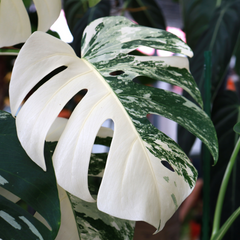
You may be familiar with the monstera plant as a popular houseplant choice. However, we’re talking about its rare cousin, the Variegated Monstera. These plants are known for their large, glossy green leaves that feature contrasting splashes of white or yellow.
A big reason why variegated Monsteras are hard to find is because you can't grow them from seeds to get that cool, mixed color look. Sure, you can plant the seeds, but what grows will just be a regular, all-green Monstera deliciosa. So, if you see someone selling "Monstera variegata seeds" for cheap, think twice! There are people out there who try to make money by tricking plant fans who are excited to follow the latest trends.
This rare beauty originates from the tropical forests of Central America. Its rarity comes from the slow rate of propagation and the high demand among collectors. Don’t be shocked by the high price tag you might see on these! And be cautions that super variegated leaf segments might brown and wither faster than others. The lack of green pigment is unable to photosynthesize, which can make these plants tricky.
2. Philodendron Spiritus Sancti
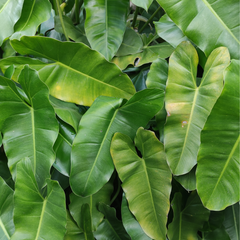
This elusive philodendron is known for its long, elegant leaves that have a distinctive velvety texture and dramatic ribbing. It is considered to be one of the rarest house plants known. Its rarity stems from its limited natural habitat in Brazil, where it faces threats from habitat destruction and overcollection. This scarcity, combined with its striking appearance, makes it a prized possession among plant enthusiasts.
Caring for a Philodendron Spiritus Sancti requires a bit of attention to replicate its natural tropical environment, but not impossible. Investing in a pebble tray or humidifier can help maintain the moisture it loves.
3. Anthurium Clarinervium

Known for its heart-shaped, velvety leaves with striking white veins, the Anthurium Clarinervium originates from the dense forests of Mexico. Like most of these unique plants, it requires a well-draining soil mix and consistent moisture without becoming waterlogged. Its unique texture and pattern make it a standout addition to any indoor garden.
4. Alocasia Azlanii

Dubbed the 'Red Secret' for its metallic, almost iridescent leaves, the Alocasia Azlanii is a true gem among houseplants. This plant was recently propagated in 2016 and its foliage can feature contrasting veins in greens, reds, deep purples and salmon pinks. Native to Borneo, its rarity is attributed to its specific care needs and slow propagation rate.
5. Rhaphidophora Tetrasperma Variegata

The Rhaphidophora Tetrasperma Variegata is a sought-after variety of the Rhaphidophora Tetrasperma, which is known for its distinctive variegated foliage. This plant is often referred to as a "Mini Monstera" because of its resemblance to the Monstera Deliciosa. However, this is not actually a Monstera, but it shares a similar look with its split leaves. The variegation in the leaves can include patterns of white, cream, or light yellow. These colors contrast beautifully against the green, making each leaf unique.
Several factors play a part in why this is considered a rare house plant. The variegation in this plant is caused by a genetic mutation. These sections of the plant may have less chlorophyll, causing them to grow more slowly. Also, during propagation, not all cuttings will retain this variegation that makes them so unique – creating a limited supply.
6. Pink Princess Philodendron

Much like the name suggests, the Pink Princess is coveted for its pink variegated foliage. Some plants can even look like pink hearts coming off the vines! The unpredictability of the variegation gives each leaf a different pattern making it a striking plant among collectors.
7. Fiddle Leaf Fig Bambino
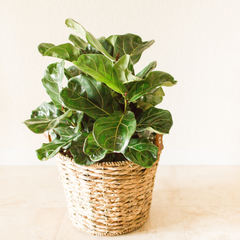
The Fiddle Leaf Fig Bambino is a dwarf variant of the well-known, Fiddle Leaf Fig. This rare house plant is known for its compact size and of course the iconic, broad violin-shaped leaves. Its popularity, especially in the interior design world, often outstrips supply, contributing to its rarity. Additionally, the genetic stability of the Bambino variety is difficult to maintain. This means that not all propagated plants will retain the desired compact growth habit, reducing the number of available plants for sale.
Perfect for smaller spaces, it requires bright, indirect light to mimic the dappled sunlight of its West African rainforest origin. Remember to dust its leaves regularly to ensure it can photosynthesize efficiently.
8. Jewel Orchid (Ludisia Discolor)
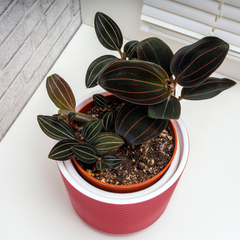
Unlike most orchids that are prized for their flowers, the Jewel Orchid is celebrated for its velvety leaves that have iridescent veins. These veins can look gold, red or white which gives them a jewel-like appearance.
A typical orchid prefers bright, indirect sunlight. However, this rare indoor plant can also tolerate the shade. This makes it an ideal plant for those less sunny spots in your home. It's also important to note this orchid likes a well-draining orchid mix and a more humid climate. So keeping a humidifier ready may come in handy.
9. Variegated Alocasia Frydek

The variegated Alocasia Frydek is often simply referred to as the Alocasia 'Frydek'. This rare house plant is a particularly striking variety of the Alocasia genus, known for its unique foliage and coloration. This beauty features heart-shaped, velvety dark green leaves that are dramatically marked with bold white or cream-colored veins. The variegation in the leaves is not just aesthetically pleasing but also quite unusual, as each leaf pattern can be distinct.
This plant grows slowly and is usually spread by dividing it into smaller parts, which can be tricky and risky because of its delicate roots. The slow growth and difficulty in propagation add to its rarity. It's a real treasure for those who are ready to take on the challenge of caring for it.
10. Begonia Maculata ‘Wightii’
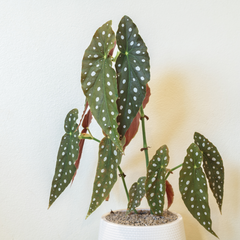
This rare begonia is often called the Polka Dot begonia because of its angel-wing-shaped leaves and silver spots. Another fun feature of this plant are the undersides of the leaves - they are usually a deep red or purple. These colors play well with the clusters of white flowers that this begonia produces.
This particular begonia can be sensitive to environmental stressors like big temperature changes, direct sunlight and overwatering. If the plant has a well-draining soil, indirect sunlight and good humidity - you will be successful!
Care Tips for Your Rare House Plants
Caring for these rare house plants offers an exciting opportunity to learn how to nurture and cultivate thriving plants that not everyone is familiar with. Here are some general tips for successfully growing these rare indoor plants:
- Research is key: Understand the specific needs of each plant. This includes light, water, humidity, and temperature requirements.
- Proper soil: Use well-draining soil tailored to each plant's needs. Many tropical plants prefer a mix rich in organic matter, while succulents and cacti require a more porous mix.
- Water wisely: Overwatering is a common mistake. A good rule to follow is making sure the soil is dry before watering. Of course, you can adjust according to the plant's natural environment.
- Humidity: Many of these plants come from humid environments. Use humidifiers, pebble trays, or regular misting to maintain the required humidity levels.
- Lighting: Provide adequate light according to each plant's preference. Use grow lights if natural light is insufficient, especially for plants native to bright, sunny climates.
- Temperature: Keep your plants away from drafts and sudden temperature changes. Most tropical plants prefer a consistent temperature that mimics their natural habitat.
Final Thoughts
These 10 rare house plants are all unique and beautiful, but might seem intimidating to care for. However, when you break it down, their basic needs are all pretty much the same. We recommend starting with our Houseplant Chunky Mix for the best results. Water the plants only when the soil starts to dry out, which is usually no more than once a week. In fact, for most of these rare plants in our mix, watering every 10-14 days is just right. They also thrive best in bright, indirect light. If you stick to these simple guidelines, you're well on your way to growing a successful collection of houseplants.
So the next time you’re looking for a new plant project or a great gift, consider one of these rare plants. Reach out with any questions you may have. As always, we’re here to help you Grow Happy Plants!
